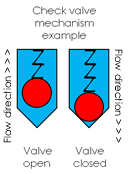
|
DISCLAIMER - IMPORTANT: PLEASE READ
This article is provided for information purposes only. You should only attempt any
procedures explained here if you are competent to perform the task and have the appropriate
tools and materials, including any relevant safety equipment.
Readers acting upon this article do so at their own risk and no responsibility is
accepted by the author or publisher for any loss or damage incurred by following the
article or failing to follow it.
If in doubt always consult a properly qualified tradesperson or other competent person.
|
|
WHAT IS A CHECK VALVE?
A check valve (sometimes referred to as a 'non-return valve') is a valve that allows
water to pass in only one direction.
This means that the valve can be used to prevent water from flowing back along a pipe,
possibly carrying contaminants with it.
Check valves are usually found where there is a need to protect the drinking water
supply from contamination, typically where a supply pipe feeds both drinking water
and water used for other purposes, such as a garden tap.
HOW DOES A CHECK VALVE WORK?
A check valve is basically a tubular valve body containing a small device to prevent
backwards flow ('backflow') of water along the pipe.
The precise type of device will depend on the purpose and use of the valve, but as
a simple example might consist of a small spring-loaded ball-bearing inside the body
of the valve.
The ball bearing sits in a cone shaped housing. Normally water flows from the narrow
end of the cone into the valve body.
|

DOUBLE CHECK VALVE
 |
The strength of the spring that holds the ball bearing in place is set so that normal
water pressure through the hole in the correct direction of flow overcomes the spring,
moves the ball bear away from the hole and lets water through the valve.
If the water flow reverses direction it forces the ball bearing back into the narrow
end of the cone and over the inlet hole, blocking the water flow back towards the
source.
When a water goes the wrong way through the valve it helps the spring push the ball-bearing
back into the conical housing, blocking the hole and stopping the water flow back
through the pipe.
SINGLE AND DOUBLE CHECK VALVES
Depending on how important it is to stop the reverse flow of water along a pipe either
a single or double check valve may be required.
A single check valve will provide a reasonable degree of protection where the contaminant
is unlikely to injure health or damage appliances connected to the water supply, but
where a more serious risk exists a double check valve can be fitted.
As the name implies, a double check valve has two in-line devices to stop the backflow
of water. This means that there is far less likelihood of contaminated water flowing
back along the pipe.
Where there is an extreme risk of contamination and check valves are considered insufficient
to protect the water supply an air gap is usually used
to prevent backflow.
|
|
© 2012 Home
|